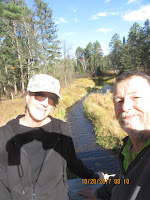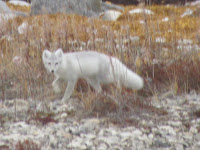 We learned that just North of Duluth stood the Whispering
Giant that Peter Wolf Toth had carved and donated to the State of Minnesota. Of
course, we couldn’t let that stand without paying a visit to take in another
magnificent Toth carving.
We learned that just North of Duluth stood the Whispering
Giant that Peter Wolf Toth had carved and donated to the State of Minnesota. Of
course, we couldn’t let that stand without paying a visit to take in another
magnificent Toth carving. Outside the visitor center in Two Harbors Minnesota is the
state’s gift from Toth. We don’t believe we have yet to see a Whispering Giant
with hands – all we’ve seen so far have only been massive head carvings. It was
fun to see a little variation here on the Range.
Outside the visitor center in Two Harbors Minnesota is the
state’s gift from Toth. We don’t believe we have yet to see a Whispering Giant
with hands – all we’ve seen so far have only been massive head carvings. It was
fun to see a little variation here on the Range. We got really lucky. Our nephew Jonny is currently a student
at the University of Minnesota, Duluth campus. It turned out that the only day
we happened to be staying in Duluth was the day he was in a choir concert open
to the public. We scooped up our tickets and by a fluke, got to see Jonny
perform in a very interesting and complex demonstration of Barouche era music.
(The tall guy, not unlike his Auntie) Fun!
We got really lucky. Our nephew Jonny is currently a student
at the University of Minnesota, Duluth campus. It turned out that the only day
we happened to be staying in Duluth was the day he was in a choir concert open
to the public. We scooped up our tickets and by a fluke, got to see Jonny
perform in a very interesting and complex demonstration of Barouche era music.
(The tall guy, not unlike his Auntie) Fun!
Talk to you soon!



















































